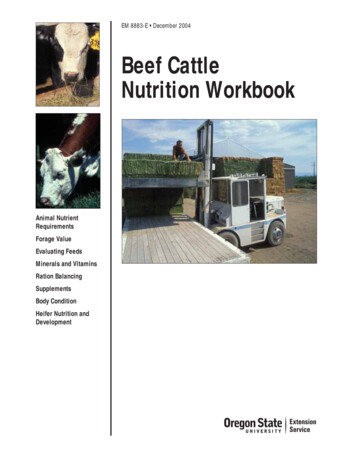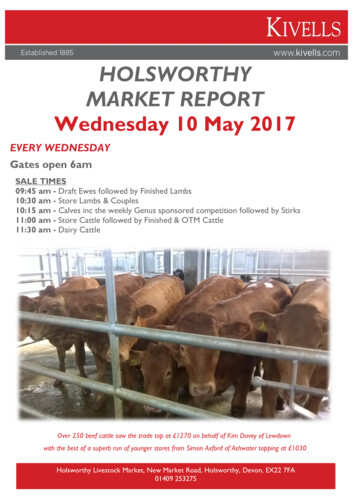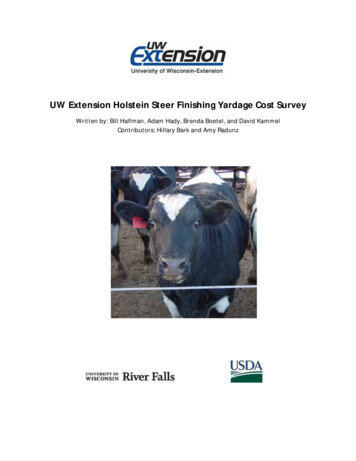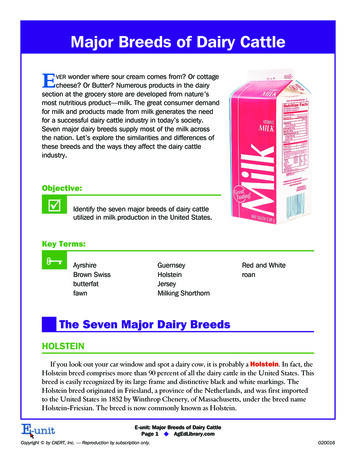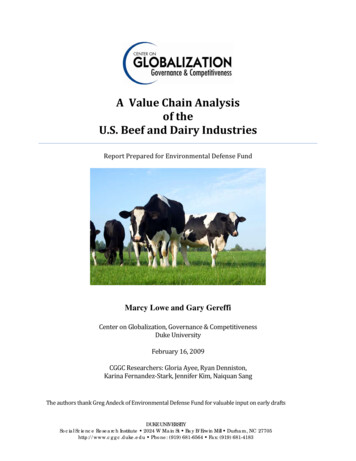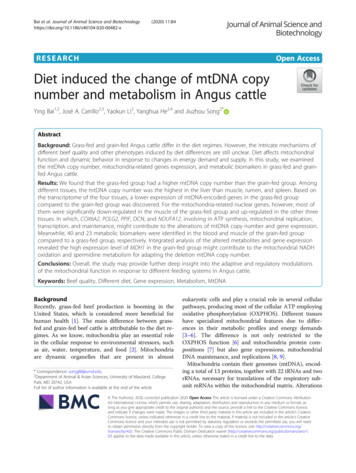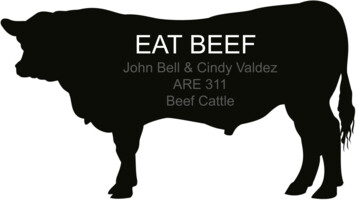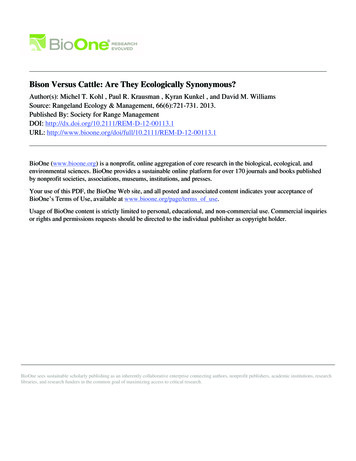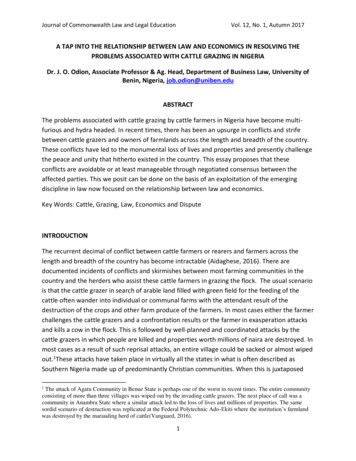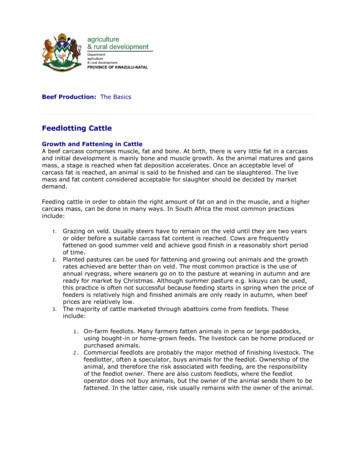
Transcription
Beef Production: The BasicsFeedlotting CattleGrowth and Fattening in CattleA beef carcass comprises muscle, fat and bone. At birth, there is very little fat in a carcassand initial development is mainly bone and muscle growth. As the animal matures and gainsmass, a stage is reached when fat deposition accelerates. Once an acceptable level ofcarcass fat is reached, an animal is said to be finished and can be slaughtered. The livemass and fat content considered acceptable for slaughter should be decided by marketdemand.Feeding cattle in order to obtain the right amount of fat on and in the muscle, and a highercarcass mass, can be done in many ways. In South Africa the most common practicesinclude:1.2.3.Grazing on veld. Usually steers have to remain on the veld until they are two yearsor older before a suitable carcass fat content is reached. Cows are frequentlyfattened on good summer veld and achieve good finish in a reasonably short periodof time.Planted pastures can be used for fattening and growing out animals and the growthrates achieved are better than on veld. The most common practice is the use ofannual ryegrass, where weaners go on to the pasture at weaning in autumn and areready for market by Christmas. Although summer pasture e.g. kikuyu can be used,this practice is often not successful because feeding starts in spring when the price offeeders is relatively high and finished animals are only ready in autumn, when beefprices are relatively low.The majority of cattle marketed through abattoirs come from feedlots. Theseinclude:1. On-farm feedlots. Many farmers fatten animals in pens or large paddocks,using bought-in or home-grown feeds. The livestock can be home produced orpurchased animals.2. Commercial feedlots are probably the major method of finishing livestock. Thefeedlotter, often a speculator, buys animals for the feedlot. Ownership of theanimal, and therefore the risk associated with feeding, are the responsibilityof the feedlot owner. There are also custom feedlots, where the feedlotoperator does not buy animals, but the owner of the animal sends them to befattened. In the latter case, risk usually remains with the owner of the animal.
Profit Margins in FeedlottingFactors affecting the profit margin of a feedlot operation include the price margin, feedmargin, management, cost of feed, buying price of feeders and selling price, which isusually quoted as a carcass price.Price marginThe profit or loss which the feedlotter makes as a result of an increase or decrease in pricefrom the time the animal is bought (the cost price) to the time the animal is sold (saleprice), is called the price margin and is calculated as follows:Price margin Initial live mass X (sale price/kg - cost price/kg)Price margin includes the difference between purchase price and selling price resulting frombeef price fluctuations as well as improvement in carcass quality due to feeding. Thefeedlotter cannot control price fluctuations and must therefore rely on a prediction of whatprices will be when stock are sold at a future date. Making use of a positive price margin iswhat is commonly called speculation. Although profits are potentially high, risk is high andpeople lacking experience often lose money with speculation.When buying livestock, most feedlotters make use of the price per kg live mass for theircalculations. They must therefore know the dressing percentage of the animal. Dressingpercentage, varies and feedlotters base the value they use on experience and a knowledgeof the type of animal and its body condition. Lean animals have a dressing percentage of49%, which increases to as much as 60% at a high level of finish. However, at a fat score of2 to 3, the mean dressing percentage varies from 54 to 56%.Feed marginThe profit or loss a feedlotter makes as a result of live mass gain in relation to cost of feedconsumed, is called the feed margin and is calculated as follows:Feed margin Live mass gain X (sale price/kg - cost/kg gained)A feedlotter can influence feed margin by ensuring, through good management, thatoptimal growth rates are achieved and by taking steps to obtain the best feed at the bestprice.Other expensesOther expenses incurred by feedlotting include the following:agents commission,slaughtering costs,carcass condemnations,transport,interest on capital,salaries of management and labour,machinery costs,mortalities and veterinary costs (disease control, medicines, vaccinations, veterinarian)and pretreatment (growth stimulants, dipping, dosing, vaccination).Feedlotters can improve production profit by manipulating some expenses, but others, e.g.agent's commission, are fixed. Mortalities must be monitored carefully to ensure that a highloss rate does not severely limit profits. A mortality rate of 1% to 2% is accepted as normal.
Feedlot profitThe feedlot profit margin is a function of price margin, feed margin and other expenses.Adding these three together, indicates profit or loss for the period of time over which thecalculation is made. Feedlot managers need to keep a close watch on feedlot profit, which isa very sensitive measure of the efficiency of management.Feedlot ManagementThe price paid for feedlot cattle or their initial value (cost/kg), is a critical factor affectingthe profitability of a feedlot enterprise, especially when a small or negative feed marginexists. A positive feed margin can only be realized with high mass gains and a relatively lowcost of feed. The cost of the feedlot ration relative to the beef price and live mass gain thusexerts a major influence on the cost of gain.Because of the high proportion of energy required to ensure good feedlot performance, thecost of carbohydrate, which is usually included in most feedlot rations in the form of maize,hominy chop or one of the other grains, in relation to the beef price, is a significant factordeciding profitability of a feedlot enterprise. This is usually expressed by the ratiobeef:maize price, which experience has shown must be more than 13:1 for feedlotting to beprofitable. Feedlotters can make substantial profits when the beef to feed cost price ratio isfavourable. Some of this profit must be held over to tide the enterprise over in a subsequentperiod, which is sure to come, when profit margins are negative.Because average daily gain declines toward the end of the feeding period, where animalsare fed for too long a period of time (are over-finished), a negative feed margin resulting inreduced profit margins is likely.It can therefore be stated that management will have a major influence on the profitabilityof a feedlot enterprise. Management aspect that are important include:1.2.3.4.Ensuring that the right type of animal is bought at the right price and at the righttime. In some larger feedlots, feedlot managers rely on the services of experiencedbuyers.The feedlot ration must be balanced in respect of nutrient content, must be matchedto the type of animal fed and should be the most cost effective ration available at thetime of feeding. In most feedlots the manager achieves these goals by keepingrecords of animal performance and monitoring results. A nutritionist is usuallyemployed to do the ration balancing because this is a highly specialized taskrequiring a great deal of time monitoring feed quality and costs of ingredients.The daily running of a feedlot is the major task of the feedlot manager. This includescare that feed bins are full all the time, that fresh water is available to the livestockcontinuously, that animals are processed and adapted on arrival and that animals aremarketed when ready.Diseases can be a problem in a feedlot. The services of a veterinarian to advise ondisease prevention and the treatment of sick animals is a cost well justified. Theadage "prevention is better than the cure" is very true in feedlotting.Type of AnimalBreedCattle can be classified according their maturity type. Early maturing types start depositingfat at an earlier age and can be market ready at a live mass of 380 to 400 kg. Latematuring types can reach market readiness at a live mass of 500kg or more.As a general rule, dual purpose breeds are late maturing types with high growth rates andrequire a longer feeding period. The British beef breeds, excluding the Sussex which ismedium to late maturing, are generally early maturing and although their growth rates are
relatively lower, they need a shorter feeding period to reach a good carcass finish. Indicuscattle can do well in feedlots, but temperament and problems with laminitis can occur.Table 14. Maturity types of different breeds of cattle.Range in framescoresFrame Score Maturity TypeBreed1Dexter1 to 2Nguni1 to 2Angus1 to 3Potfontein Rooies1 to 3Afrikaner1 to 3Herefords2 to 4Rietvlei Reds2 to 4Shorthorn2 to 4Sussex3 to 5Symons3 to 5Smythe3 to 5Bonsmara3 to 5Bongihlati3 to 5Brangus3 to 5Brahman3 to 5Braford3 to 5Tauricus3 to 5Beefmaster3 to 5Limousin4 to 6Drakensberger4 to 6Santa Gertrudis4 to 6Simbra4 to 6South Devon4 to 6Simmentaler4 to 6Gelbvieh4 to 6Pinzgauer5 to 7Charolais5 to 7Early 1 - 223Medium 3 - 5456Late 6 - 77
A problem encountered in practice is that, especially in Natal, most cattle entering feedlotsare crossbreeds and maturity type does not always follow as a mean of the breeds crossed.In addition, there has been a trend to breed larger cattle, resulting in late maturing typeswithin breeds traditionally known as early maturing. Fortunately, experienced stockmen canjudge maturity type with reasonable accuracy.SexFemales are earlier maturing than steers and steers in turn are earlier maturing than bulls.Bulls can do well in feedlots, but often cause problems by fighting. Females can do well infeedlots, but often have poor growth rates partly because they reach carcass finish at anearlier age and there is a tendency to be tardy in sending them for slaughter. Disruptionscaused by females coming on heat could be a contributory factor.AgeAnimals can be placed in the feedlot at any age, usually after weaning. In practice animalstend to arrive at feedlots shortly after weaning (7 to 9 months of age), as yearlings (12 to18 months of age) or at two and a half years of age. In most feedlots there is nodifferentiation in feeding regime between animals of different ages and it has been foundthat irrespective of the age, animals tend to gain about 150 kg and are then ready forslaughter. Cattle placed on high energy rations at an early age tend to deposit fat morerapidly than if they are kept on low energy diets for a time before being placed on a highenergy ration.In cases of emergency caused by food shortages e.g. drought, a question often asked iswhether cows and calves should be separated before entry to the feedlot. The best practiceis to place the cow in the feedlot with her calf. As the cow reaches carcass finish, the calfwill have started eating concentrate. The dam can be removed from the feedlot and the calfremain until it in turn is ready for slaughter.Irrespective of breed, sex or age, a proportion of animals (usually about 10%) do not adaptto feedlotting. It is best to cull these animals as soon as possible. They can be identified bytheir poor performance in the initial stages of feeding.Feeding SystemMany feedlotters mix their own ration, usually a complete feed, using the most readilyavailable ingredients at the best price they can bargain for. Where home-produced feeds areavailable at low cost e.g silage, the profitability of a feedlot can be improved.Other feeding systems, include:1.2.Buying in a complete feed. If large volumes of feed are bought, a better price can benegotiated. This option must always be investigated, especially when beef prices aregood and ingredients are difficult to obtain. Cost of transport often offsets gainsmade on the feed price.Cafeteria feeding systems have been developed and have the advantage that theanimal selects an increasingly concentrated diet over time, which leads to greaterefficiency of feed utilization. The two cafeteria systems commonly used are thefinisher feed system and the PRAM (protein-roughage-additive-mineral) system.To ensure profitability, many feedlots employ a nutritionist who reformulates the ration orfeeding system continuously. Taking care that adaptation to new feeds is not a problem, anutritionist can buy in ingredients and formulate the cheapest ration in relation to animalperformance by monitoring markets continuously.
Adaptation and ProcessingRuminants must always be adapted to a new feeding regime. Adaptation allows themicroflora in the rumen to adapt to the new substrate they must grow on. This usually takesup to three weeks. When adapting livestock to high concentrate diets, this process is bestdone by a gradual increase in energy content of a diet. This is called an adaptation ration.With modern additives, such as the ionophores, the adaptation period is not as critical as itused to be. However, although most feedlotters no longer make use of an adaptation ration,a good practice is to place animals on hay for a day or two before supplying the high energyration. Initially the intake of the concentrate is best limited to 1 to 2 kg per day beforeanimals are allowed free access. This also assists animals to overcome the stress related totransportation to the feedlot.On arrival at the feedlot animals must be processed. Processing varies from feedlot tofeedlot, but usually includes:1.2.3.4.5.6.7.Dose and dip. Dipping is essential, but many people question the need to de-wormanimals arriving at a feedlot. A positive response to dosing is often not seen, possiblybecause many farmers dose their animals before selling them.Vaccinate all animals against botulism, anthrax, quarter evil, IBR and any otherdiseases the veterinarian considers essential in the area where the feedlot issituated.Administer growth promotents. These have been shown to be highly cost effective.Injecting Vitamin A is usually worth the nominal cost involved.Identify and number the animals for record keeping purposes.On arrival at a feedlot it is good practice to group animals according to size and sex.Large animals tend to bully smaller animals and keep them away from feed troughs.The initial weight of animals should be recorded, preferably after 7 to 10 days in thefeedlot. At this time, careful observation can identify poor performers and these can,at a next weighing which ideally takes place two to three weeks later, be culled if themass gains confirm the earlier observations.Horned animals are a problem. Dehorning sets an animal back a great deal. Leavinganimals with horns can lead to severe losses resulting from damage to other animalsand bruising. It is best to refrain from buying in animals that have not been properlydehorned.Filling the FeedlotFeedlot managers must be aware of the fact that keeping a feedlot enterprise running, acontinuous income is needed. The only way this can be achieved is by having livestock tosell all the time. This is a difficult part of feedlotting, because animals remain in a feedlot for90 to 120 days. The feedlotter must therefore predict market demand, and consequentlypredict selling price at least three months ahead. A continuous source of feeders is needed,but not always available.Livestock can be obtained directly from farmers or be bought by private treaty through anagent or at livestock auctions. Where a buy-in feedlot system is used, buyers must beexperienced in evaluating the potential for fattening of different types of animal (maturitytype, age, gender) in relation to the market demand (price) of different grades of carcass.Funds to buy in animals must be available at all times. A lack of funds to buy in animalswhen prices are favourable could lose an opportunity to make a profit.TransportFeedlot owners obtain a large proportion of income from cattle transport as well asspeculation.
Size of FeedlotThere is not an optimal size for a feedlot. Even a farmer feeding a single animal can make aprofit. However, feedlotting often runs at a loss and a small operator can not absorb suchlosses for any length of time. On the other hand, in the case of a large enterprise where itssole source of income is the feedlot, the feedlot must be large enough to pay for runningcosts such as salaries, transport, cost of equipment and so on. At present costs andsalaries, a feedlot producing less than 1000 head of cattle per month (i.e. has 3000 to 4000head of cattle in the feedlot at any time), can not produce enough money to cover overheadcosts.Deaths and CondemnationsAlthough deaths occur in feedlots, where losses exceed 2% prompt action must be taken tofind and eliminate the cause(s) of the mortalities in order to minimize losses.Slurry DisposalSlurry disposal is a major issue in most feedlots and warrants attention. Waste can be wetor solid and, if not properly taken care of, can result in a fly and insect problem. Flies andinsects must be combatted in a feedlot because they worry animals and increase stress.Stress has a negative effect on growth rate.DiseaseA feature of crowded accommodation is the rapid spread of disease. Apart from the betterknown cattle diseases that can appear in feedlots, there are a number of diseasesassociated with feedlotting. These are better studied in more detailed publications or are leftto the veterinary profession to manage. A feedlot manager needs to be aware of thepotential danger of these diseases, especially infective diseases such as IBR which canspread through a feedlot at a very rapid rate and even if mortalities are relatively low,profits are eroded by depressed animal performance.
A beef carcass comprises muscle, fat and bone. At birth, there is very little fat in a carcass and initial development is mainly bone and muscle growth. As the animal matures and gains mass, a stage is reached when fat deposition accelerates. Once an acceptable level of carcass fat is reached, an animal is said to be finished and can be .

